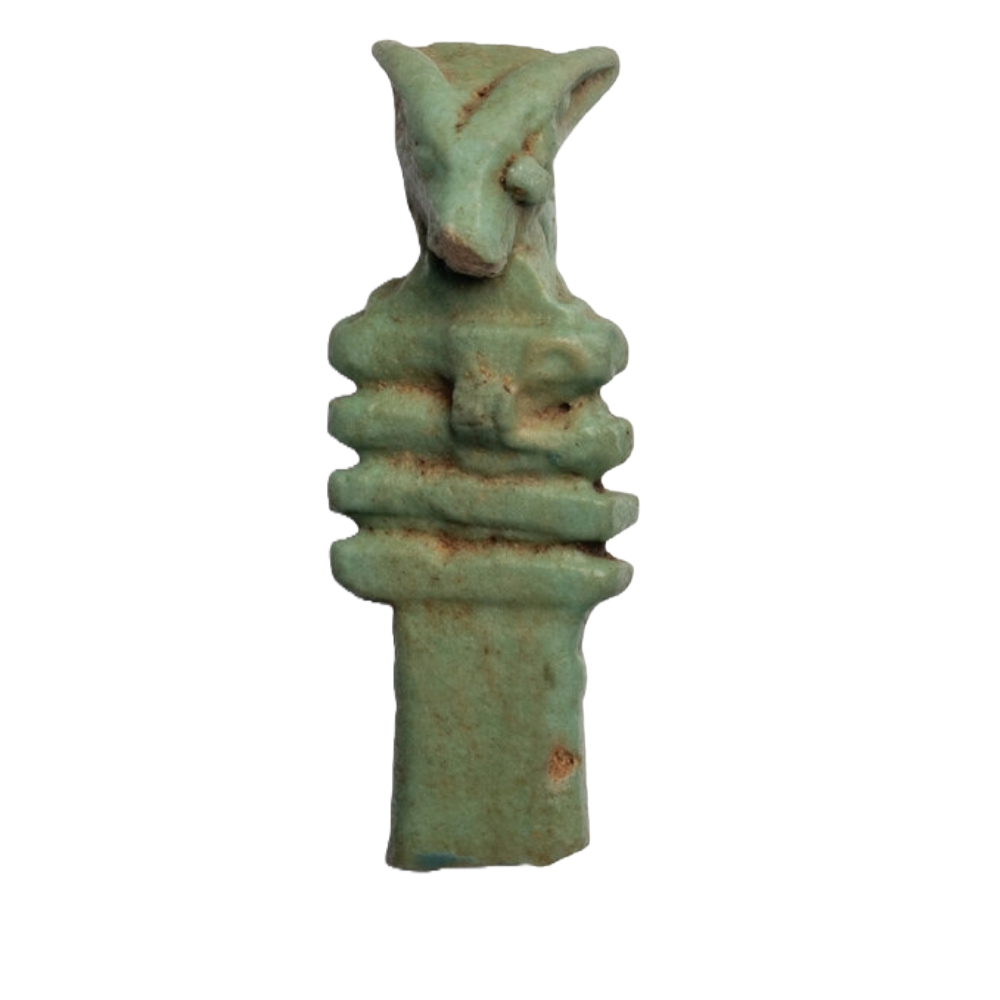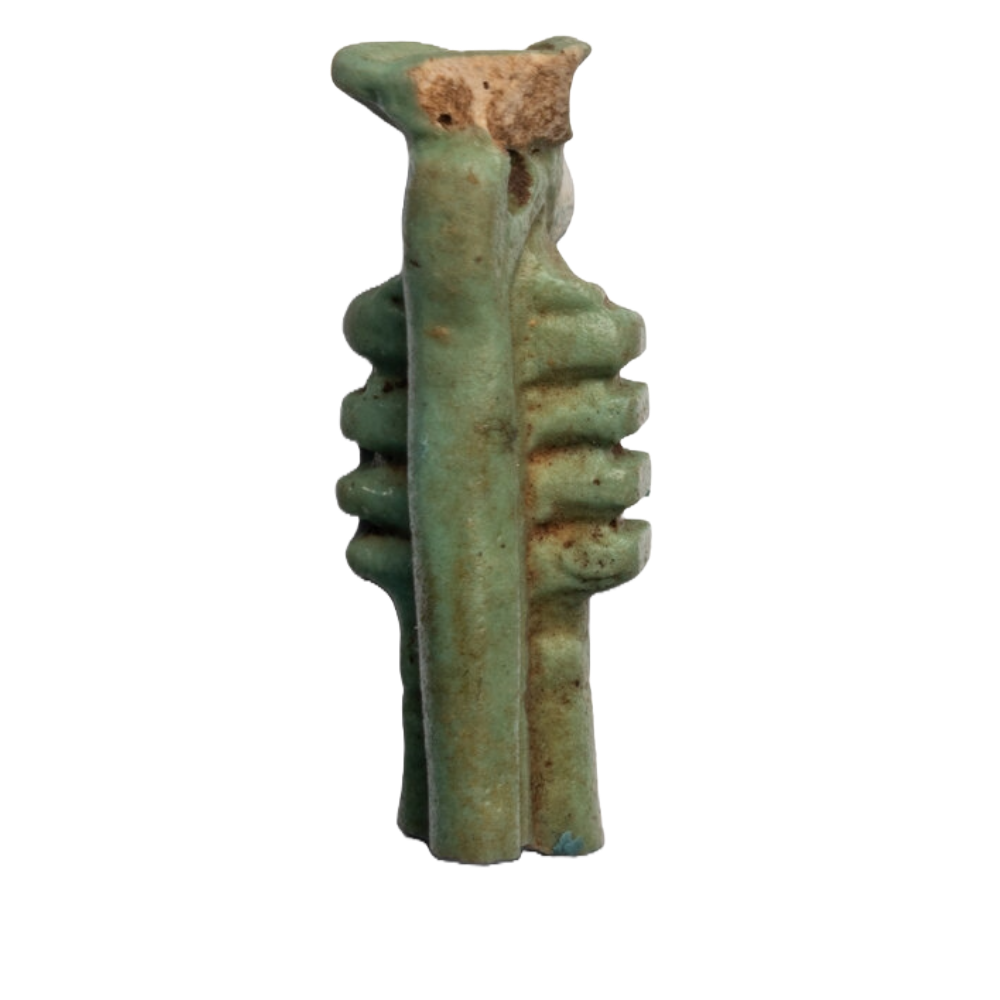 Image 1 of 2
Image 1 of 2

 Image 2 of 2
Image 2 of 2



Unique Green Djed Amulet with Khnum
This very striking unique green Djed amulet is rather odd, as the the top of this Amulet seems to feature the head of a Set-animal often referred to as a Khnum, and usually only often seen in either in depictions or in physical staff/Scepters. Such cases are often referred to as Ptah-scepters or “Was-scepters”
In Egyptian ritual contexts, the Set-animal’s head appears prominently on was-scepters, staffs of power held by gods, kings, nobility and those of higher status, and is especially linked with the deity Ptah, the Memphite creator god, when forming the Ptah-Seker-Osiris triad. These scepters, also called power scepters or Ptah-scepters, were emblems of sovereignty over both the physical and metaphysical realms. To find such a head on a Djed pillar is exceptionally rare, using two powerful emblems: the Djed for stability and eternal life, and the Set-animal for cosmic strength and dominion over chaos.
The amulet thus unites two potent hieroglyphic symbols—the Djed (stability) and the Was (domination)—each deeply entrenched in ancient Egyptian theology. The Set-animal's presence here may represent the transformative taming of chaos (Set) through the regenerative strength of Osiris (Djed), offering the wearer not just protection in the afterlife, but a metaphysical reinforcement of order triumphing over disorder.
The Djed featured on the amulet is also sometimes referred to as the pillar of stability, associated with the god Osiris and the concept of eternal life. Carved in the classic form of a column with four horizontal crossbars, the Djed represents the backbone or spine of Osiris, the god of the afterlife, and is intrinsically linked to themes of rebirth, strength, regeneration and cosmic order.
Djed amulets such as this were frequently crafted in faience, a glazed non-clay ceramic material favored by the Egyptians for its bright luster and symbolic color. This particular piece is rendered in deep turquoise green, a hue connected to regeneration, fertility, and the Nile’s life-giving waters. The surface remains well-preserved, with traces of its original glaze still evident, enhancing the object's visual and spiritual resonance.
The Djed pillar first emerged during Egypt’s Third Dynasty, appearing as an openwork decorative element incorporated into the architecture above a wall in a structure west of the Heb-Sed Court within the Step Pyramid enclosure at Saqqara. Its earliest known use as a personal amulet, however, does not appear until nearly five centuries later, in the late Old Kingdom. From that time onward, it became one of the most widespread and recognizable funerary amulets in ancient Egyptian burial practices.
Traditionally placed among the wrappings of the deceased during mummification—typically over the spine or lower back—the Djed was believed to ensure the resurrection of the body and reinforce the deceased’s connection to the divine. The Spell 151 from the Book of the Dead specifically references the Djed, invoking it to “raise the Osiris [deceased] up and strengthen his backbone.”
Though gold was the ideal material according to funerary texts, most surviving examples are crafted from green-glazed faience, glass, or, during the First Intermediate Period, glazed steatite. Blue faience, true glass, and even lapis lazuli were also favored. These blue and green hues were not merely aesthetic but deeply symbolic, representing renewal, fertility, and the promise of rebirth.
This amulet would have been worn or buried with both elites and commoners, serving not only as a ritual object but also as a tangible assurance of stability in this life and the next. Its enduring form and sacred meaning remained popular from the Old Kingdom through the Ptolemaic period, with variants found in tombs across Egypt, especially in Abydos, Thebes, and Saqqara.
Elegant in its simplicity yet rich in cosmological symbolism, this Djed amulet offers collectors and scholars alike a direct connection to the ancient Egyptian worldview a culture that sought permanence in the face of mortality, and saw in symbols like the Djed a path to eternal stability
This very striking unique green Djed amulet is rather odd, as the the top of this Amulet seems to feature the head of a Set-animal often referred to as a Khnum, and usually only often seen in either in depictions or in physical staff/Scepters. Such cases are often referred to as Ptah-scepters or “Was-scepters”
In Egyptian ritual contexts, the Set-animal’s head appears prominently on was-scepters, staffs of power held by gods, kings, nobility and those of higher status, and is especially linked with the deity Ptah, the Memphite creator god, when forming the Ptah-Seker-Osiris triad. These scepters, also called power scepters or Ptah-scepters, were emblems of sovereignty over both the physical and metaphysical realms. To find such a head on a Djed pillar is exceptionally rare, using two powerful emblems: the Djed for stability and eternal life, and the Set-animal for cosmic strength and dominion over chaos.
The amulet thus unites two potent hieroglyphic symbols—the Djed (stability) and the Was (domination)—each deeply entrenched in ancient Egyptian theology. The Set-animal's presence here may represent the transformative taming of chaos (Set) through the regenerative strength of Osiris (Djed), offering the wearer not just protection in the afterlife, but a metaphysical reinforcement of order triumphing over disorder.
The Djed featured on the amulet is also sometimes referred to as the pillar of stability, associated with the god Osiris and the concept of eternal life. Carved in the classic form of a column with four horizontal crossbars, the Djed represents the backbone or spine of Osiris, the god of the afterlife, and is intrinsically linked to themes of rebirth, strength, regeneration and cosmic order.
Djed amulets such as this were frequently crafted in faience, a glazed non-clay ceramic material favored by the Egyptians for its bright luster and symbolic color. This particular piece is rendered in deep turquoise green, a hue connected to regeneration, fertility, and the Nile’s life-giving waters. The surface remains well-preserved, with traces of its original glaze still evident, enhancing the object's visual and spiritual resonance.
The Djed pillar first emerged during Egypt’s Third Dynasty, appearing as an openwork decorative element incorporated into the architecture above a wall in a structure west of the Heb-Sed Court within the Step Pyramid enclosure at Saqqara. Its earliest known use as a personal amulet, however, does not appear until nearly five centuries later, in the late Old Kingdom. From that time onward, it became one of the most widespread and recognizable funerary amulets in ancient Egyptian burial practices.
Traditionally placed among the wrappings of the deceased during mummification—typically over the spine or lower back—the Djed was believed to ensure the resurrection of the body and reinforce the deceased’s connection to the divine. The Spell 151 from the Book of the Dead specifically references the Djed, invoking it to “raise the Osiris [deceased] up and strengthen his backbone.”
Though gold was the ideal material according to funerary texts, most surviving examples are crafted from green-glazed faience, glass, or, during the First Intermediate Period, glazed steatite. Blue faience, true glass, and even lapis lazuli were also favored. These blue and green hues were not merely aesthetic but deeply symbolic, representing renewal, fertility, and the promise of rebirth.
This amulet would have been worn or buried with both elites and commoners, serving not only as a ritual object but also as a tangible assurance of stability in this life and the next. Its enduring form and sacred meaning remained popular from the Old Kingdom through the Ptolemaic period, with variants found in tombs across Egypt, especially in Abydos, Thebes, and Saqqara.
Elegant in its simplicity yet rich in cosmological symbolism, this Djed amulet offers collectors and scholars alike a direct connection to the ancient Egyptian worldview a culture that sought permanence in the face of mortality, and saw in symbols like the Djed a path to eternal stability
Height: 3 cm & 8 mm (38mm)
Width: 14 mm
Length: 10 mm
Weight: 4.03 grams
Provenance: Freeman’s & Hindman, The Wonder Collection of Antiquities and Ancient Art, Part 2: Sale 2102, 16 August 2024, Donald Wonder (1938-2023), California & New Jersey ; Thence by descent.
Similar Pieces:
A similar-ish piece is displayed in the Met Museum, ascension number: 10.130.2444
Another similar piece was sold by Den of Antiquity: (here)